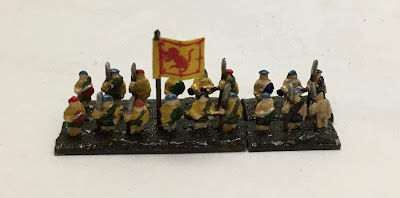 |
| 2mm Infantry Battalia 2:1 shot to pike so classed as mixed fire power Now this looks like a big body of troops |
Because I started these rules with a single battle in mind (Naseby 1645) I didn't give a great deal of thought to any troops other than the basic British Civil War types. As time passed and the rules started to take on a life of their own other troop types started to make their presence known! This started with the Scots at Marston Moor, led me to the 1645 campaign of Montrose and onwards to Cromwell in Scotland. Then other wars and campaigns started to impinge, what about Irish troops for Montrose or the Thirty Years War or the Irish Confederate wars or ..... well you get my drift!
I realised that when I started drafting the rules the definitions and traits used to calculate a units combat effectiveness (CE) actually acted as a 'pick n mix' troop generator and with only a little tweaking I could use them to create almost all of the 17th Century troop types found in Western and Central Europe. Whether it will also work for Eastern Europe remains to be seen as I haven't considered the Polish Lithuanian Commonwealth and their enemies or the Ottoman armies as yet.
I will start with a recap on previous posts on the rules, A units ability to stay in a fight is measured by it's initial Combat Effectiveness (CE) rating. As this reduces they become more brittle until they eventually break and flee on a CE of zero (assuming that they are not replaced with reserves before that point. A unit’s CE is reduced by one step once one hit per base has been inflicted on the unit. This makes larger units more robust than smaller ones as they have more bases. To offset that advantage large units suffer movement penalties.
In turn CE is calculated by starting with a base value of five and adding or subtracting from that based upon training, experience and status. That latter factor is based on whether the unit is elite or unwilling. The resulting value is the units CE and has an impact on reaction tests and is reduced by combat outcomes and reaction test results. On top of those factors a unit may have a trait of being armoured, poorly equipped and for melee have a weapon reach adjustment. Basic weapons differences for ranged combat are also included. All units have a combat style ranging from Shock to Skirmish which create different combat adjustments and impact willingness to enter melee.
A units Experience, training and status will be tied into the army they are part of, based upon historical performance. More on that in future posts though.
At the moment I have:
Reiters/Currassiers are defined as armoured with a weapon reach advantage for pistols in melee. They fight as shock, mixed shock or mixed fire power. They tend to deploy in deeper formations than either Lancers or Harquebusiers
Demi-Lancers are Reiters armed with a Lance and close combat weapon but no firearms. They are classed as shock. Just about unknown in Western Europe in the period.
Harquebusiers are defined as cavalry with a weapon reach advantage for using pistols in melee. They may also be able to stand off and shoot in support of Reiters if armed with carbines or similar early in the period. Later they replace Reiters as the mounted melee arm. As a result their fighting style may be mixed fire power, mixed shock or (pure) shock.
 |
| 2mm Irregular Miniatures Horse using their Armoured Pistolier castings These could be Reiters or Harquebusiers depending on the paint scheme |
Poorly armed horse are defined as Harquebusiers who lack back and breast plates and rely mainly on close combat weapons such as swords. They have the poorly armed combat adjustment and have no reach advantage in melee. These represent units such as the Royalist Northern Horse. They will count as mixed shock. They are not classed as light cavalry as they are still a melee type.
Scots (and other) unarmoured lancers are treated as having a melee reach advantage for using lances. Otherwise they count as Harquebusiers or poorly armed horse depending on the level of equipment. In all cases they will be shock or mixed shock.
 |
| Irregular Miniatures 6mm Covenanting lancers |
Light Horse are defined as skirmishers. They have carbines, or arquebus, pistols and close combat weapons.
For Infantry I have;
Bodies of pike and shot are classed as mixed shock if pike outnumber shot or mixed firepower if shot out number pike. Pike bases (only) gain a bonus in melee and a reach advantage.
 |
| 6mm mixed fire power infantry, these are later Irregular Miniature sculpts |
 |
| Same again but in 2mm and a deeper (Dutch style) formation |
Musket only units will count as mixed firepower or firepower depending on their willingness to enter melee.
 |
| 6mm Musket only formation |
Scottish Highlanders are given mixed shock as a combat style and all fight as if pike armed in melee but with a pole arm reach advantage. If they lack firearms they count as having bow support from the rear ranks which gives a melee bonus in the first round of combat.
 |
| 6mm Highlanders from Irregular Miniatures (some of my earliest 6mm) |
That about covers the main troop types. Play tests will tell me if it all works as intended.
And just as I order another set of 2mm ECW you post this. Strangely enough I’ve gone with the same style pike blocks and musketeers as you this time.
ReplyDeleteDo you want a copy of the final version of the rules or are you sticking with the set you used before. If you decide to run an online campaign count me in.
Delete